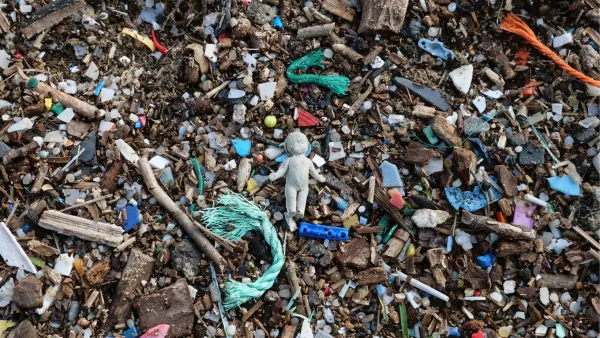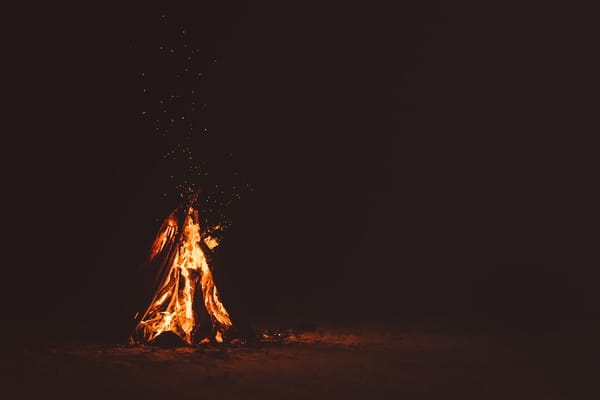Lots of people feel that the week between Christmas and the New Year is an uncomfortable space. Everything slows down until we can hear the death rattle of the soon to pass year. Many feel unmoored when sitting it with an approaching end. But one of the only things I know I know how to do is attend the dying. It’s mostly a matter of witnessing and comforting.
The last year is dead, but I don’t know how to leave it alone.
I find the last days of the year hold a lot of both. And so I feel useful, and even a little sure. I know what I am doing. But death is beyond me. Because at some point it is no longer possible to attend the dead. And so the first week of the year is the space that always leaves me feeling unmoored, in time and space. The last year is dead, but I don’t know how to leave it alone.
I spent January 1st 2022 in Southern California, my first and always home. Grief for 2021 pushed me out into the morning light of the new year. I walked around my in-law’s neighborhood in Whittier. It had rained the night before. Everything felt washed and familiar. It looked like so many of the neighborhoods from my childhood. Sidewalks piped in front of stucco houses, both a little cracked after baking too long. Avocado trees in front yards, above ground pools in backyards. I decided to walk until I saw something that didn’t feel like home.
Instead, I stopped when I saw the turkey vulture. It stood on the red tiled roof of a house with its wings spread out, drying them after a wet night. Turkey vultures have a wingspan of five to six feet. I’m not good at estimating size. But this vulture’s wingspan looked large enough to wrap me up. When I got closer, I could see how the breeze moved its feathers. They weren’t just black. There were flecks of brown too. And when I moved just past the house, I could see the inside of its wings - they were almost silver.
Its head was bare, by evolutionary design. Turkey vultures eat by plunging their heads into carcasses. Head feathers would be a liability, a breeding ground for bacteria. I sat down on the sidewalk across from the vulture, and watched. Vultures know what to do with the dead. Maybe I could learn something. I’m not the first person to have this thought. We’ve been learning from vultures for a long time.
Vultures and humans have some things in common. They can only have one or two offspring at a time, and only once each year. They can live a pretty long time. And they both evolved to eat meat.
It was that last similarity that sustained hominids like Homo Erectus, Neanderthals and then finally humans like us. Bigger brains and bodies required more fat and protein to survive. Hunting megafauna was difficult and dangerous. Scavenging meat from carcasses was lower risk. And death was plentiful! But finding the dead in time to get fresh meat could be difficult for hominids. It was easy for vultures.
There is a fascinating article in Anthrozoös, The Vulture in the Sky and the Hominin on the Land: Three Million Years of Human–Vulture Interaction. The authors argue that Neanderthals and humans looked to the sky to know where a feast lay on the ground. When they saw vultures circling, they knew they’d found a meal. They’d set off in the direction of the birds to get their share. Like me, they sat and watched.
Vultures follow migrating herds because the rate of death goes up during migration. Some scholars think hominids first left Africa because they followed the vultures following herds. Vultures only went to places where they could feed on the dead. Humans need death to live too. Walking into unknown lands was less terrifying with those birds flying in the distance. People helped vultures too. When people began to settle they created more death because they created more life through animal domestication.
As humans lived in denser settlements, vultures kept them safe from the dangers that can breed in rotting bodies. They ate their fill of the stuff that putrefies, leaving the bones behind. The bones didn’t go to waste, they were turned into tools, toys and instruments. People understood the value of vultures and incorporated their likeness and bones into religious rituals. The earliest known musical instrument is a flute made of a vulture bone.
Because there is no discernable difference between male and female vultures, many ancient cultures thought all vultures were female. Around 200 CE, a Roman writer claimed that because there were no male vultures, female vultures relied on the wind to reproduce. While aloft, they would “open their beaks to the east wind, and the inrush of air impregnates them.”1 In some ancient cultures, vultures were used to represent motherhood.2 Maybe because vultures remain with their babies for a long time. They have to, like human babies, vultures are born helpless.
I love the vulture/mother comparison for many reasons. Here’s two of them:
The first has to do with motherhood and domesticity. We are used to mothers being compared to creatures who build nests. Turkey vultures don’t build nests. They lay their eggs in protected areas like crevices in cliffs and abandoned buildings. But there is no manufactured softness, the eggs are deposited onto bare surfaces. I wonder how we’d view domesticity differently if we stopped thinking about it as nest-making and thought more about it as finding fortification. Male and female vultures partner in feeding the baby once it’s hatched.
I wonder how we’d view domesticity differently if we stopped thinking about it as nest-making and thought more about it as finding fortification.
The second reason has to do with motherhood, life and death. In, The Vulture in the Sky and the Hominin on the Land, the authors write, “In mesoamerican traditions, vultures were associated with transformation and the life-giving properties of crops, rain, sun, fire and light.”3 Vultures consume the dead and transform it into life.
My motherhood made me feel like a transmutation chamber, producing death from life. Each time I had a baby, I cried. I’d transformed matter into her living form, but because she was now alive she would someday be consumed by death. It’s a conflict I’ve never been able to separate from my experience of motherhood. I feel more represented by a vulture than the soft creatures - cats, bunnies, mice - often used to depict motherhood.
My motherhood made me feel like a transmutation chamber, producing death from life.
Old World vultures and New World vultures are not related to one another. Which is a bit baffling because they are so similar. But they are evidence of convergent evolution, the process that produces two separate species that adapt in similar ways to similar pressures. My turkey vulture on the roof was not related to the vultures in ancient Egyptian inscriptions, but an Ancient Egyptian would recognize its outline, and understand its work. And they’d appreciate the significance of its scientific name, Cathartes aura, or “cleansing breeze.”
So would the Greek historian Herodotus. Around 430 BCE, he wrote about vultures when he wrote about the Magi, a religious order in Zoroastrianism. It’s a gorgeous religion. Zoroastrianism’s origins are so far back in history we can’t find them. No one knows when Zoroaster, the founder, lived. Zoroastrianism’s influences can be seen in much younger religions, like Christianity and Islam.
Despite their religion’s reach, much of what westerners know about the early Magi is what the Greeks wrote about them. So what many westerners know about the Magi is just how the Greeks perceived them. Herodotus wrote that Magi performed the rites of Persian burials, and that it was their tradition to expose the dead to scavenging vultures. He claimed that when the body was cleaned by the birds, the bones were covered in wax and then buried.
Herodotus was wrong about a lot, but Zoroastrianism historically practices ritual exposure of the dead. Herodotus seemed scandalized by it, but it’s incredibly sensible. Decaying bodies can harm before and after burial, spreading disease and contaminating water supply. But once the vultures have done their work, the remains are clean and can be buried safely. Zoroastrians were not the only people to practice ritual exposure of the dead. It’s found through time and place, with different meanings and beliefs attached. In Tibet, for example, ritual exposure of the dead is called a sky burial. I think it’s really lovely.4
The Greeks understood the Magi as a priestly order concerned with the alchemic and esoteric. The word magic comes from that understanding. Even “Zoroaster” is a Greek phonetic translation of the Avestan name of the religion’s founder. “Zoroaster” means “living star” but the Avestan name is not related to stars at all.The Ancient Greeks, and then the Romans, believed that the Magi were gifted astrologers. They may well have been! But that western emphasis is an artifact of the Greek phonetic translation. It’s funny the way that translation still influences the stories we tell.
In much of the world, January 6th is the day Christians celebrate the Magi’s visit to the Christ child. The Magi in the story follow a star to Christ because they’d long been associated with stars by the time the Gospel of Matthew was written.5 I wonder, though, how we’d view their visit if they’d followed a vulture instead. It many ways, it’d make more sense.
Death is already in the text. The gifts given by the Magi were often associated with burial rites. Some people interpret them as acknowledgment that Christ was born to die. (Not so different from my babies, I guess.) Transformation is in the text too. Christ turns death into eternal life. (Very different from my babies, I guess.) And there is the mother, attending her helpless offspring. When Mary saw a vulture circling in the distance, would she have felt a sudden sense of recognition? (And what does it mean, that I feel there’s more familiar about the vulture than about the Mary I’ve been given in Bible stories?)
The California sun got a bit higher in the sky and the vulture stretched its neck. I stretched my neck too. Other people were on their morning walks, but I was the only one watching the vulture. Which isn’t such a surprise. Turkey vultures are an everyday visitation in Whittier. In 1906, Esther Craigmile wrote about the “Common Birds of Whitter, California.” The Whittier she describes, largely undeveloped and covered in “bright yellow mustard assuming the proportions of small trees,” no longer exists. But she’d recognize the bird I watched on the rooftop,
“Cathartes aura. Turkey Vulture.-- A constant sight soaring above the hills.”6
The vulture was still drying its feathers when I’d watched long enough to learn something. Death comes with its own attendants. It doesn’t need me. The first week of each year is when the bones of the last year need to be picked clean. And it’s not my job to do the picking. There is some odd comfort in imagining a cosmic mother-figure ripping the year’s flesh from its bones. Her head free of feathers so the rot doesn’t stick to her. I wonder if she sees me from a distance, and feels a sense of recognition?
This year, I did what I did last year on my walk back to my in-laws house. On Sunday, January 1st, I left the body of the previous year in a place away from me, exposed to the elements that know what to do with dead. On Sunday, January 8th, I’ll return to the dead year once last time, to gather up its bones. Most I’ll bury. But one will fit into my hand, just so. That one I’ll turn into a flute, to play through the next years that will die too.
And each time my lips touch bone, I’ll be reminded that at least for that moment, I know what to do with death.
1 Edwards, Karen. “Milton’s Reformed Animals: An Early Modern Bestiary: T-Z.” Milton Quarterly 43, no. 4 (2009): 241–308. http://www.jstor.org/stable/24461933.
2 Strika, Fiorella Ippolitoni. “PREHISTORIC ROOTS: CONTINUITY IN THE IMAGES AND RITUALS OF THE GREAT GODDESS CULT IN THE NEAR EAST.” Rivista Degli Studi Orientali 57 (1983): 1–41. http://www.jstor.org/stable/41881189.
3 Federico Morelli, Anna Maria Kubicka, Piotr Tryjanowski & Emma Nelson (2015) The Vulture in the Sky and the Hominin on the Land: Three Million Years of Human–Vulture Interaction, Anthrozoös, 28:3, 449-468, DOI: 10.1080/08927936.2015.1052279
4 WOESER, and Dechen Pemba. “Rinchen, the Sky-Burial Master.” Manoa 24, no. 1 (2012): 92–104. http://www.jstor.org/stable/42004645.
5 As I’ve gotten older, the story of the Magi visiting a baby born to save the world has become more weighted with symbolism, and the intent of the people telling the story, than reality. But there is some coherence in the narrative about the Magi seeking out a child born to save the world. Some early versions of Zoroastrianism said that cosmic disorder would be vanquished by the collective good of all believers - all were saved by many. I really love that version of salvation. If there are many saviors, why wouldn’t a baby born in Bethlehem be one of them? Why couldn’t a baby born in the hospital down the street be one of them? What if we treated all babies like our salvation?
6 Esther Craigmile. “Common Birds of Whittier, California.” The Wilson Bulletin 18, no. 3 (1906): 83–87. http://www.jstor.org/stable/4154090.








